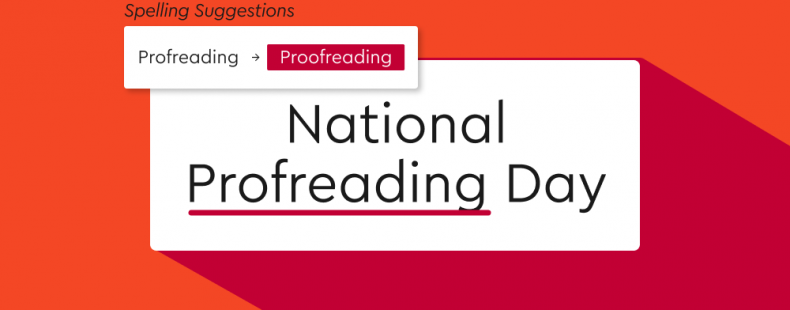By Ashley Austrew, Journalist and Writer
It’s a good day to double check your work for mistakes. That’s because today, March 8, is National Proofreading Day! It can’t be a coincidence that National Proofreading Day comes right on the heels of National Grammar Day, which took place on March 4. After all, proofreading is a key part of making sure your writing and grammar are at their best.
In honor of this important holiday (hey, ask an editor about how they feel about proofreading), come with us as we take a deeper look into what terms like proofreading and editing actually mean, and share some of our best strategies for making sure your writing is error-free.

Proofreading vs. copyediting vs. editing
Proofreading, copyediting, and editing are terms people use interchangeably in everyday settings, but are they actually the same thing? While they all refer to the process of looking over a document for errors, there are some subtle differences:
What is copyediting?
A copyedit is what happens when writing is edited for publication. Copyeditors check for errors in punctuation, spelling, and grammatical structure. They also keep an eye on the “big picture” elements of the writing, such as theme, voice, and style. Essentially, a copyeditor goes over a piece of writing with a fine-tooth comb and makes sure every facet of the work is polished, correct, and as effective as it can be before it goes out into the world.
What is proofreading?
Proofreading is the process of reading printer’s proofs (more on this term in a moment), copies, and other documents in order to detect and mark errors to be corrected. In publishing, proofreading is the last step in the editing process, during which the final, copyedited version of a manuscript is checked one last time for errors before it is published.
So, what is that proof in the word proofreading? In this case, the proof is not the irrefutable evidence that your brother ate the last cookie. The use of proof to mean “a preliminary impression of a printed text” dates back to the 1600s. Historically, printers used plates set with type to apply the ink to paper. So a printer’s proof would have been the first impression that the printing press made on paper. Today, the definition is fleshed out as “a trial impression, as of composed type, taken to correct errors and make alterations.”
What is editing?
Both proofreading and copyediting are specific types of edits that fall under the larger umbrella of editing, or “preparing text for publication by checking and improving its accuracy, clarity, etc.” Often, we casually use the term editing or proofreading to describe any process of cleaning up text. Copyediting may be more common in professional settings, such as in publishing houses or newsrooms.
Even if you’re not formally publishing your writing, editing is what’s happening when you look over that follow-up text after a great first date, or when you’re emailing your boss with updates on your latest project. You’re making sure your writing is in its finest form and ready to be shared with the world. That’s an important step.
Why it’s important to proofread your writing
Proofreading matters, even in casual communication. We’ve all seen hilarious autocorrect fails, right? Proofreading is what prevents you from accidentally thanking your dinner party host for the great “pork lion” instead of “pork loin.” Of course, there’s more to proofreading than just avoiding embarrassing mistakes.
Is your writing clear?
Whether you’re writing an email to a colleague, leaving a list of instructions for the babysitter, or working on a cover letter for a great new job opportunity, proofreading ensures you’re communicating clearly. If you read through your work, correct your spelling and punctuation, and make sure you’re using the clearest language possible, your communication is going to be much more engaging and effective.
Your writing will be crystal clear with these top grammar tips. Check them out!
Is your wording professional?
Proofreading can help you stand out from the crowd in the workplace. According to the National Association of Colleges and Employers, 82% of employers want candidates with strong written communication skills, and 59.6% prefer someone who is detail oriented. Leaving mistakes in your writing can impact the impression you make on superiors and coworkers. Proofreading will help you put your best foot forward.
Proofreading tips to perfect your writing
Read it out loud
Find a quiet spot and practice reading your work out loud. It doesn’t matter if you’re working on something that won’t ultimately need to be read aloud. Doing this in the editing stages forces your brain to comb over every single word and catch small mistakes you might have missed. As an added bonus, it can also help you identify and fix any awkward words or sentences that might cause readers to stumble.
According to the National Association of Colleges and Employers, 82% of employers want candidates with strong written communication skills, and 59.6% prefer someone who is detail oriented.
Walk away
When you’ve been concentrating on the same piece of writing for a long time, it’s easy for your brain to gloss over mistakes. It may start to autofill missing words or overlook simple punctuation errors. Stepping away from your work for a half hour (or even longer) can help you return with fresh eyes that are ready to catch those pesky errors.
Print the document
Staring at a computer screen is hard on your eyes, and it could make some errors harder to spot. Try printing your work and going over it with a pen or highlighter to note any fixes it might need.
Use Grammar Coach ™
Spot errors in real time, and get suggestions for how to fix them with Thesaurus.com’s Grammar Coach ™. This powerful tool is like having a personal tutor while you write, and it can help you spot overused words, spelling errors, and grammar mistakes.
Ashley Austrew is a freelance journalist and writer from Omaha, Nebraska. Her work has been published at Cosmopolitan, Scary Mommy, Scholastic, and other outlets. For more by Ashley, read: Make Your Language The Star Of National Grammar Day With These Tips | “Does ‘Spark Joy’ Mean The Same Thing In English And Japanese?” | Is There A Difference Between “Calling In” And “Calling Out”? | Why Do Journalists Avoid The Word “Liar”? | What Kind Of Songs Get To Be Called “Country Music”?















